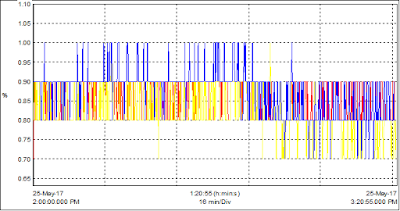In our electrical system when current and voltage are distorted by non-linear loads.
CURRENT AND VOLTAGE HARMONICS:
Harmonics develop as current and voltage harmonics are the result of current harmonics. Current harmonics develop by the present of non-linear loads in power system like VFD, Inverters, UPS, Televisions, Computers, Semiconductor Circuits, Welding Machines, Arc Furnaces running. This types of loads are acts like a harmonics current sources. So, The output current can be complex depending on the type of load and its interaction with other loads in the system. The distorted current waveform represented as the sum of current wave of fundamental frequency and its multiple harmonics. |
| CURRENT HARMONICS Higher Harmonics is observed in case of R Phase. |
But voltage harmonics not develop by non-linear loads. The distorted waveform flow throw th system impedance and it cause harmonics voltage drop across the impedance. This way supply voltage waveform is distorted. Result is voltage harmonics are generated.
**Higher voltage harmonics generated source:- High impedance transformers, Running Long distance cables, etc.
 |
| VOLTAGE HARMONICS It is observed that Harmonics in case of the B phase is a bit higher than that of the other phases. |
Disadvantages of Current & Voltage Harmonics:
In the electrical system the rms current flowing is increased by Current Harmonics, Result is Increase the power losses. Entire all the distribution system is affected by Current Harmonics, It may result increased eddy current losses and hysteresis losses in transformer and motors resulting in overheating, overloading in neutral conductors, nuisance tripping of circuit breakers, over stressing of capacitors, interference with communication etc. They can even lead to overheating and saturation of reactors.
Voltage harmonics effect the entire system irrespective of type of load. They affect sensitive equipment throughout the facility like those that work on zero-voltage crossing as they introduce voltage distortions.


Post a Comment
Post a Comment